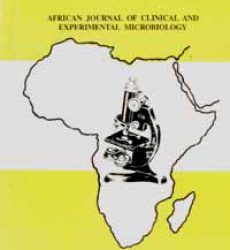Ezeonu, C. M., Garba, S. A., Adabara, N. U., and Kuta, F. A.
Department of Microbiology, School of Life Sciences, Federal University of Technology, Minna, Nigeria
Correspondence to: scholajane@yahoo.com
Abstract
Background: Transfusion of hepatitis B virus (HBV) infected blood represents a major but avoidable means of HBV transmission, which unfortunately still account for millions of global HBV infections annually. Method: This study determined the prevalence of HBV infection among 550 blood donors aged 18 to 60 years from selected hospitals and blood transfusion centres within the Federal Capital Territory, Nigeria, using hepatitis B surface antigen (HBsAg) rapid diagnostic test (RDT) kit and Enzyme linked Immuno-sorbent Assay (ELISA). Representative positive and negative samples for RDT and ELISA were tested by both conventional and real-time polymerase chain reaction (PCR) assay Results: Forty nine (8.9%) and 14 (2.8%) out of the 550 blood donors tested positive for HBsAg with the RDT and ELISA respectively. Replacement donors had higher prevalence rate of the HBV infection than voluntary donors. The highest prevalence of HBV infection was recorded among the 30–39 year age group. The difference in the rate of infection between the males and the females was not statistically significant (p>0.05). A perfect agreement between RDT and PCR and fair agreement between ELISA and PCR were observed. Conclusion: This study report a high prevalence of hepatitis B virus infections among blood donors in Abuja, Nigeria which underscores the need for proper screening of blood for transfusion to completely eliminate the incidence of transfusion transmitted HBV infections.
Key words: Blood, Malaria, Hepatitis, Rapid, Immuno-sorbent, Polymerase
Received March 18, 2018; Revised March 18, 2019; Accepted March 20, 2019
Copyright 2019 AJCEM Open Access.
This article is licensed and distributed under the terms of the Creative Commons Attrition 4.0 International License (http://creativecommmons.org/licenses/by/4.0), which permits unrestricted use, distribution and reproduction in any medium, provided credit is given to the original author(s) and the source.
Prévalence de l’infection par le virus de l’hépatite B chez les donneurs de sang dans le Territoire de la capitale fédérale, Abuja, Nigéria
Ezeonu, C. M., Garba, S. A., Adabara, N. U., and Kuta, F. A.
Département de microbiologie, École des sciences de la vie, Université fédérale de technologie de Minna, Nigéria
Correspondance à: scholajane@yahoo.com
Abstrait Contexte
La transfusion de sang infecté par le virus de l’hépatite B (VHB) représente un moyen important mais évitable de transmission du VHB, qui représente malheureusement toujours des millions d’infections mondiales au VHB chaque année. Méthode: Cette étude a déterminé la prévalence de l’infection à VHB chez 550 donneurs de sang âgés de 18 à 60 ans de certains hôpitaux et centres de transfusion sanguine situés dans le Territoire de la capitale fédérale, au Nigéria, à l’aide du kit de test de diagnostic rapide (TDR) de l’antigène de l’hépatite B (HBsAg) et Essai immuno-sorbant lié à une enzyme (ELISA). Des échantillons positifs et négatifs représentatifs pour les TDR et ELISA ont été testés à la fois par le test de réaction en chaîne par polymérase (PCR) classique et en temps réel Résultats: Quarante-neuf (8,9%) et 14 (2,8%) des 550 donneurs de sang ont été testés positifs pour HBsAg avec le TDR et le test ELISA, respectivement. Le taux de prévalence de l’infection à VHB était plus élevé chez les donneurs de remplacement que chez les donneurs volontaires. La prévalence la plus élevée d’infection par le VHB a été enregistrée dans le groupe d’âge des 30 à 39 ans. La différence de taux d’infection entre les hommes et les femmes n’était pas statistiquement significative (p> 0,05). Un accord parfait entre TDR et PCR et un accord juste entre ELISA et PCR ont Conclusion: Cette étude fait état d’une prévalence élevée d’infections par le virus de l’hépatite B chez les donneurs de sang à Abuja, au Nigéria, ce qui souligne la nécessité d’un dépistage approprié du sang par transfusion afin d’éliminer
Mots-clés: sang, paludisme, hépatite, rapide, immuno-sorbant, polymérase
Download full journal in PDF below

